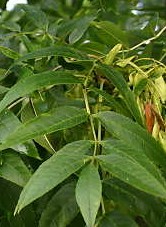 Like other members of the genus, European ash is not especially ornamental but is a large deciduous tree that does well in inhospitable places. Growing up to 80’ tall, it has pinnately compound leaves up to a foot long with oval leaflets four to six inches long. The leaves are medium green and do not change color in the fall before they drop. Some cultivars, however, have been produced that have yellow fall color. Small, inconspicuous greenish male and female flowers are produced on the same or different trees in spring before the leaves appear. Winged fruits (samaras) one to two inches long are produced in clusters by female flowers in the fall. These fruits can create a litter problem and lead to unwanted seedlings. The solution to the problem is not easy; trees may bear male flowers one year and female the next so selecting trees with only male-flowers may be difficult. Branches grow low to the ground and the light gray-brown bark of young trees becomes rigid and furrowed with maturity developing a diamond pattern. European ash can be used as a shade or lawn tree and is especially valuable for difficult places. Weeping ash is particularly appealing and was very popular in Victorian times.
Like other members of the genus, European ash is not especially ornamental but is a large deciduous tree that does well in inhospitable places. Growing up to 80’ tall, it has pinnately compound leaves up to a foot long with oval leaflets four to six inches long. The leaves are medium green and do not change color in the fall before they drop. Some cultivars, however, have been produced that have yellow fall color. Small, inconspicuous greenish male and female flowers are produced on the same or different trees in spring before the leaves appear. Winged fruits (samaras) one to two inches long are produced in clusters by female flowers in the fall. These fruits can create a litter problem and lead to unwanted seedlings. The solution to the problem is not easy; trees may bear male flowers one year and female the next so selecting trees with only male-flowers may be difficult. Branches grow low to the ground and the light gray-brown bark of young trees becomes rigid and furrowed with maturity developing a diamond pattern. European ash can be used as a shade or lawn tree and is especially valuable for difficult places. Weeping ash is particularly appealing and was very popular in Victorian times.
Type: Deciduous tree
Outstanding Features: Tolerant of difficult sites
Form: Dense crown; often wider than tall
Growth Rate: Rapid
Bloom: Inconspicuous male and female flowers on the same or different trees in spring before the leaves appear; fruit winged and borne in clusters.
Size: 60-80’ H x 60-80+ W
Light: Full sun
Soil: Soil tolerant but prefers fertile, moist, well-drained soils
Hardiness: Zones 5-7
Care: Prune to shape when young
Pests and Diseases: Ash yellows, die-back, galls, and borers
Propagation: Seed
Outstanding Selection: F. excelsior ‘Pendula’ (weeping ash).
